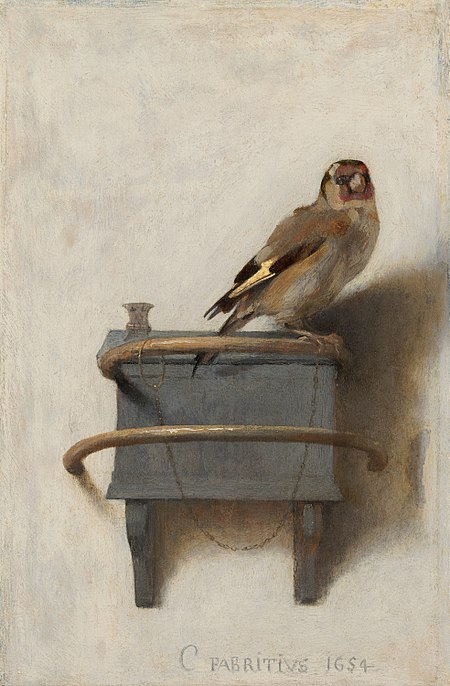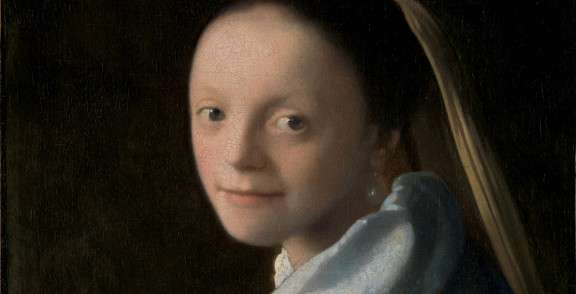Click here to access a high quality images of Fabritius' paintings.




Carel Fabritius
Midden Beemster 1622–Delft 1654
Fabritius is generally considered Rembrandt's most gifted pupil and a painter of outstanding originality and distinction. He died tragically young in the explosion of the Delft gunpowder magazine, leaving only a tiny body of work (much may have perished in the disaster). In his youth he worked as a carpenter (his name Fabritius may have been derived from the Latin" faber" from this profession) and he was probably in Rembrandt's studio in the early 1640s. He settled in Delft in about 1650.
- Gerrit ter Borch
- Carel Fabritius
- Pieter de Hooch
- Gabriel Metsu
Although only about a dozen paintings by him are known, they show great variety. His earliest surviving works (The Raising of Lazarus, National Museum, Warsaw, c.1645) are strongly influenced by Rembrandt, but he broke free from his master and developed a personal style marked by an exquisite feeling for cool colour harmonies and (even though he often worked on a small scale) unerring handling of a loaded brush (The Goldfinch, Mauritshuis, The Hague, 1654). These qualities, together with an interest in perspective, occur in the work of Vermeer, the greatest of Delft painters. Fabritius may influenced Vermeer, although it is not likely (as is sometimes maintained) that he was his master.
Carel's brother Barent (1624–1673) was also a painter, but of much lesser quality. He also may have studied with Rembrandt. He painted portraits and religious works.
expert opinion: Albert Blankert
The most prominent artist to active in Delft during this period, and the one whose work was to have the greatest consequences for Vermeer, was Carel Fabritius, Rembrandt's most gifted pupil. He moved to Delft around 1650. Fabritius had begun his career as a history painter working in Rembrandt's style, but once in Delft he began to explore new artistic problems. Taking to heart Rembrandt's dictum, 'follow nature', Fabritius attempted to create as vivid an illusion as possible. The amazingly lifelike Goldfinch, painted in 1654, the year of Fabritius's death, is an example of such an early attempt at illusionistic painting.
Fabritius maintained close ties with Samuel van Hoogstraten of Dordrecht, with whom he had established a friendship while they were both apprentices in Rembrandt's studio. In the same year in which Fabritius painted The Goldfinch, van Hoogstraten created the earliest known true trompe-l'œil painting, and initiated a tradition which was to survive well into the nineteenth century.
A trompe-l'œil painting in the Netherlands they were often called "cheaters"—depicts relatively flat, inanimate objects, against a flat, even background. Both the low relief and the lack of animation contribute to the effectiveness of the illusion. Since the objects are shown in a very shallow space, the viewer who moves in front of them does not readily perceive that they remain fixed in relation to the background, a clue which usually enables us to distinguish a painting from reality. Since the objects depicted are inanimate they do not induce any expectation of movement, and thus they convey an even more deceptive illusion than the living goldfinch represented by Fabritius. In keeping with their fascination with perfect illusions, Fabritius and van Hoogstraten also experimented with effects of linear perspective. Most of Fabritius' oeuvre has been lost: only one small panel, dated 1652, survives to testify to this aspect of his interests. It depicts a view of the Oude Langedijk in Delft, with the Nieuwe Kerk (New Church) and the Town Hall in the background. The strange distortion of the perspective has led to speculation that the canvas might once have been attached to the back wall of a peep-box. Although this is the only surviving painting of this type by Fabritius, van Hoogstraten's writings reveal that he also produced large perspective paintings.
Van Hoogstraten's peep-box in the National Gallery in London offers an indication of what Fabritius's perspective paintings must have been like. Such peep-boxes were apparently a Dutch invention. If one can overcome the traditional prejudice against artistic tricks, a peek through either of the holes in the ends of the box provides a delightful surprise: one experiences an almost perfect illusion of standing within a seventeenth-century interior. Van Hoogstraten manages to combine in this box the illusion of space with a trompe-l'œil effect: since the interior of the box can only be viewed from a fixed point, through the peephole, the spectator cannot step aside and test the reality of the space.
from:
by Albert Blankert, Vermeer: 1632–1675, London, 1978, pp. 20–21.
expert opinion: Frederik J. Duparc

The Goldfinch (Het Putterje)
Carel Fabritius
1654
Oil on panel, 33.5 x 22.8 cm.
Mauritshuis, The Hague
from:
Frederik J. Duparc, "Carel Fabritius (1622–1654) His Life and Work" in Carel Fabritius 1622–1654, Zwolle, 2004, pp. 58–60.
In 1654 Fabritius...painted the famous Goldfinch, now in the Mauritshuis. Like the View in Delft, it occupies a unique place in Dutch painting and is without precedent. The goldfinch, or European goldfinch (carduelis carduelis), is perched on a rail in front of its feeding-box, the backdrop to which is a whitewashed wall. In centuries past, the goldfinch was a popular pet that owed its Dutch nickname ("puttertje") to its adroitness in performing such tasks as drawing water ("putten") from a bowl using a thimble-sized bucket on a chain. With loving attention, Fabritius rendered the little bird chained to its feeding-box. In contrast to such contemporaries as Jan Baptist Weenix (1621–1659/61) and Cornelis Lelienbergh (c. 16251 30–after 1676) both of whom pained still lifes with dead birds also seen against a light wall, Fabritius did not lose himself in details. Here, more than ever, he proves that what he cared about was expressing his perception of the subject, not producing a depiction utterly true to life. Using relatively broad brushstrokes and occasionally bright colours, he produced a subtle rendering of an European goldfinch, caught in bright light. If one views the panel from a slight distance, the soft shadows cast by the little bird on both its feeding- box and the light wall, the shadows cast by the feeding-box on the wall, as well as the reflections of light on the two curved wooden rails, all help to create the convincing illusion that one is in fact observing a goldfinch perched by its feeding-box.
This seeming three-dimensionality places the small panel in the category of trompe-l'œil depictions. Even so, it is in a class by itself, precisely because the illusions created by most other examples of this genre depend on an elaboration of detail carried almost to extremes.
Over the years, many theories have been developed to explain the painting's original purpose, usually involving much speculation as to its trompe-l'œil effect. It has been suggested, for example, that the fairly thick panel was not originally framed as a picture but served instead as the door of a wall-cupboard. No matter what its original function, Fabritius's Goldfinch is an unforgettable masterpiece, precisely because of the simplicity and clarity of its composition.



